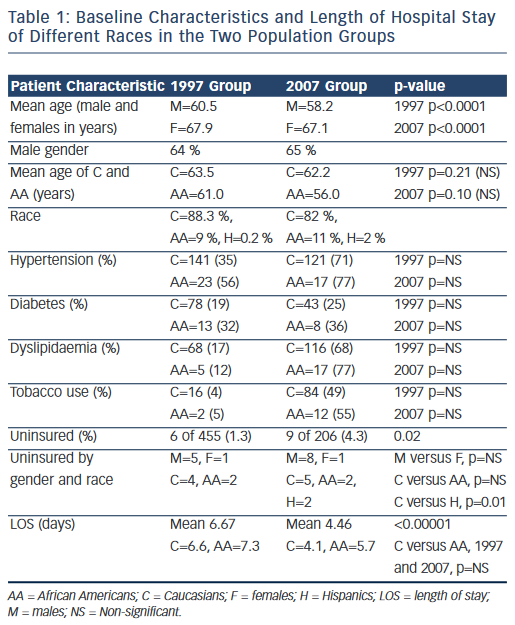Results 
Patient Characteristics
In the first group 1995-1997 (1997 group) a total of 455 subjects were included, with males comprising 64 % of the group (289 of 455). In the second group 2005-2007 (2007 group) there was a total of 206 patients, with males comprising 65 % of the group (134 of 206). The basic characteristics of the two groups are shown in Table 1. In both of our study groups there was no significant difference between African Americans and Caucasians in terms of age, prevalence of risk factors like hypertension, diabetes mellitus, dyslipidaemia and history of tobacco use. The mean age of women compared with men for first event of STEMI was 7-9 years older. As shown in Table 1 this difference was statistically significant. The prevalence of patients uninsured increased from 1.3 % in the 1997 to 4.3 % in 2007 (p=0.02). In the 2007 group, compared with Caucasians and African Americans, Hispanics were more likely to be uninsured - two of 36 young adults versus nine of 170 non-young adults were uninsured (p=1.0). In the 1997 group, three of 59 young adults versus three of 396 non-young adults were uninsured (p=0.03).
Disparities
Mortality
In the 2007 group, hospital mortality rate in all patients brought to the emergency room for STEMI was 12.6 % (26 of 206) - women 16.6 % (12 of 72) versus men 10.4 % (14 of 134). Hospital mortality for African Americans: one of 22 versus Caucasians: 21 of 170, 95 % confidence interval (CI) -0.178 to 0.022, with p=0.48. Multivariate analysis using binary logistic regression was used and only age was found to be a significant predictor of death (see Table 2).
In the 1997 group, the hospital mortality rate was 9.45 % (43 of 455) - women 12.65 % (21 of 166) versus men 7.61 % (22 of 289). Hospital mortality for African Americans (four  of 41) versus Caucasians (39 of 402), 95 % CI -0.095 to 0.096, with p=1.0.
of 41) versus Caucasians (39 of 402), 95 % CI -0.095 to 0.096, with p=1.0.
Length of Stay
As shown in Table 1, the mean LOS decreased from 6.67 days in 1997 to 4.46 days in 2007. In 2007 the mean LOS for African Americans was 5.7 days versus 4.1 days for Caucasians (p=0.09). Among the race, in 1997 the mean LOS for African Americans was 7.3 days versus 6.6 days for Caucasians (p=0.42).
Re-intervention Rate
In the 2007 group, a total of 164 percutaneous coronary interventions (PCIs) were performed for 206 patients. The remaining patients either refused invasive treatment or were not candidates for PCI. The average follow-up period was 20.5 months (range 12-32 months). During followup a total of 40 patients needed re-intervention. Re-intervention rate in African Americans being 13.6 % (three of 22) versus 21.2 % (36 of 170) in Caucasians, 95 % CI -0.231 to 0.081, with p=0.57. The re-intervention and mortality rate among the two races is shown in Figure 1.